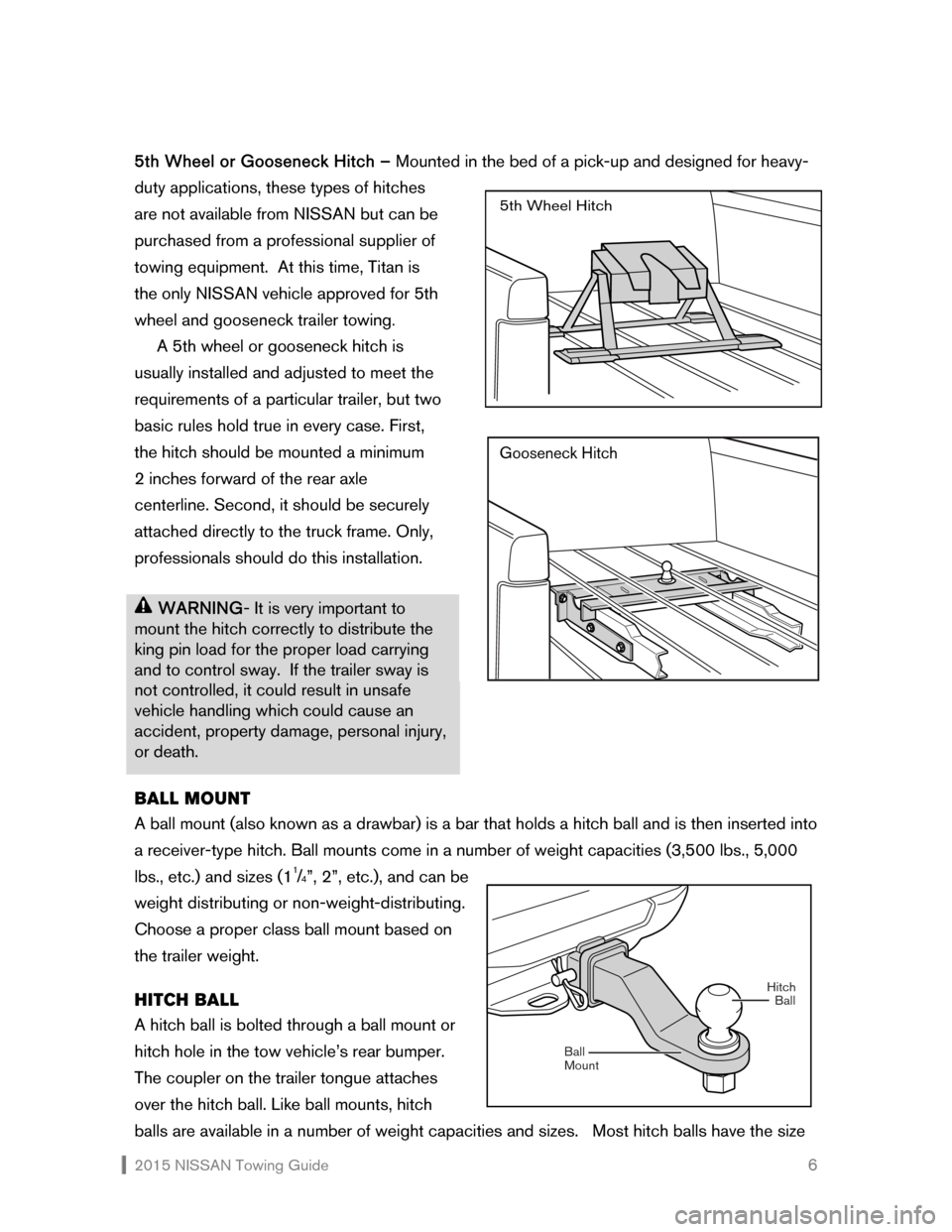tow bar NISSAN FRONTIER 2015 D23 / 3.G Towing Guide
[x] Cancel search | Manufacturer: NISSAN, Model Year: 2015, Model line: FRONTIER, Model: NISSAN FRONTIER 2015 D23 / 3.GPages: 27, PDF Size: 0.48 MB
Page 7 of 27

2015 NISSAN Towing Guide 6
5th Wheel or Gooseneck Hitch – Mounted in the bed of a pick-up and designed for heavy-
duty applications, these types of hitches
are not available from NISSAN but can be
purchased from a professional supplier of
towing equipment. At this time, Titan is
the only NISSAN vehicle approved for 5th
wheel and gooseneck trailer towing
.
A 5th wheel or gooseneck hitch is
usually installed and adjusted to meet the
requirements of a particular trailer, but two
basic rules hold true in every case. First,
the hitch should be mounted a minimum
2 inches forward of the rear axle
centerline. Second, it should be securely
attached directly to the truck frame. Only,
professionals should do this installation.
WARNING- It is very important to
mount the hitch correctly to distribute the
king pin load for the proper load carrying
and to control sway. If the trailer sway is
not controlled, it could result in unsafe
vehicle handling which could cause an
accident, property damage, personal injury,
or death.
BALL MOUNT
A ball mount (also known as a drawbar) is a bar that holds a hitch ball and is then inserted into
a receiver-type hitch. Ball mounts come in a number of weight capacities (3,500 lbs., 5,000
lbs., etc.) and sizes (1
1/4”, 2”, etc.), and can be
weight distributing or non-weight-distributing.
Choose a proper class ball mount based on
the trailer weight.
HITCH BALL
A hitch ball is bolted through a ball mount or
hitch hole in the tow vehicle’s rear bumper.
The coupler on the trailer tongue attaches
over the hitch ball. Like ball mounts, hitch
balls are available in a number of weight capacities and sizes. Most hitch balls have the size
5th Wheel Hitch
Gooseneck Hitch
Hitch
Mount BallBall
Page 23 of 27

2015 NISSAN Towing Guide 22 1 Maximum Trailer Weight values are calculated assuming a base vehicle with driver and any
options required to achieve the rating. Additional passengers, cargo and/or additional
optional equipment will add weight to the vehicle and reduce your vehicle’s maximum
towing capacity and trailer tongue load.
2 Use of a weight-distributing hitch system is re when towing over 5,000 lbs.
3 The Maximum Trailer Weight and Gross Combined Weight ratings for 5th wheel and
gooseneck trailer towing are the same as specified for conventional trailer towing.
4 Most states require a separate braking system on trailers with a loaded weight above a
specific amount. Check local regulations where you plan to tow. 7-pin connector trailer
wire harnesses are required for use with trailer brakes (available separately).
Other Recommendations and Information – Towing performance and speed are affected by
vehicle payload, tow weight, road grades, and weather conditions, including high
temperatures. See your vehicle owner’s manual for details.
TOWING
GLOSSARY
5TH WHEEL
HITCH Located just forward of the rear axle centerline, this hitch uses a king pin to
serve as the pivot point for the trailer.
BALL MOUNT A bar that holds the hitch ball and is inserted into the hitch receiver. Also
commonly called a drawbar.
BREAKAWAY SWITCH A safety device using a trailer battery that automatically applies the trailer’s
brakes if the trailer accidentally becomes separated from the tow vehicle.
A breakaway switch may be used with both electric or surge trailer brake
systems.
BUMPER HITCH A reinforced bumper designed to accommodate a hitch ball.
ELECTRIC TRAILER
BRAKES When the brakes on a tow vehicle are applied, an electric current is sent to
an actuator, which applies the trailer’s brakes.
ELECTRIC TRAILER
BRAKE CONTROLLER A device that controls the electric trailer brakes.
GOOSENECK HITCH Located just forward of the rear axle centerline, this hitch uses a ball to serve
as the pivot point for the trailer.
GROSS AXLE
WEIGHT RATING (GAWR) The maximum amount of weight each vehicle axle (front and rear) is
designed to safely carry.
GROSS COMBINED
WEIGHT RATING (GCWR) The maximum allowable combined weight of the vehicle and trailer,
including passengers and all cargo.
GROSS VEHICLE
WEIGHT RATING (GVWR) The maximum allowable weight of the vehicle, including passengers, cargo,
fuel, hitch, trailer tongue load, and any optional equipment.
KING PIN
LOAD The amount of trailer (5th wheel or gooseneck) weight pressing down on the
tow vehicle hitch.